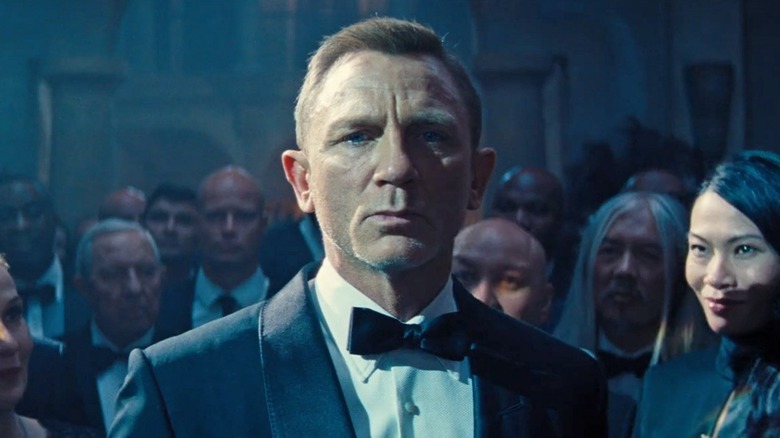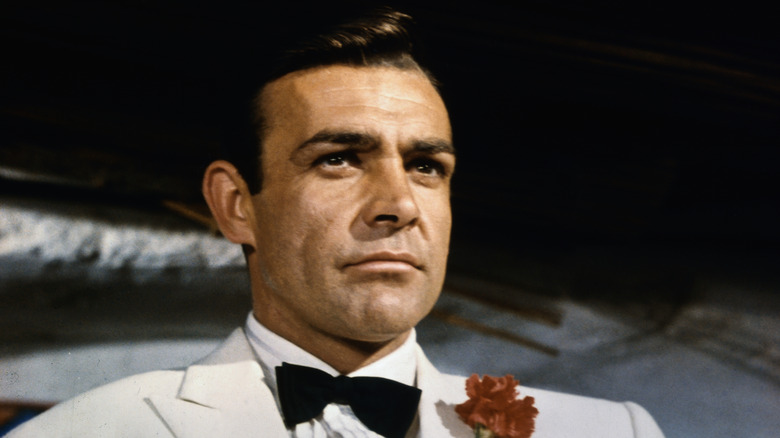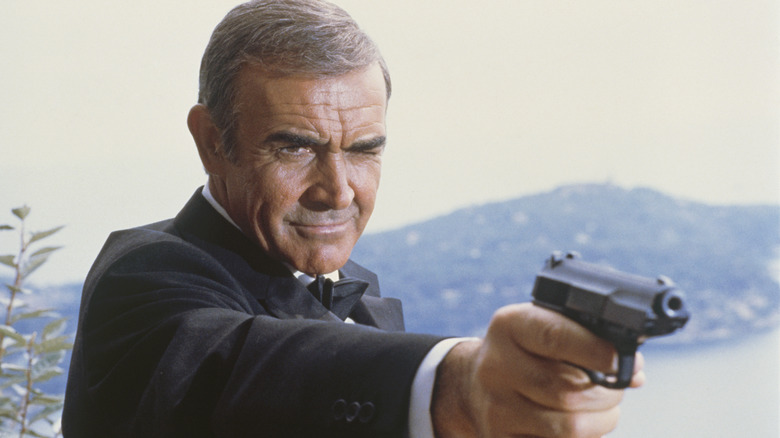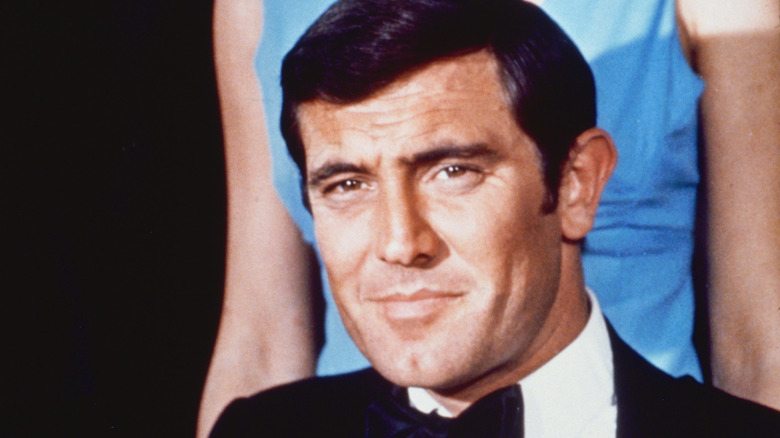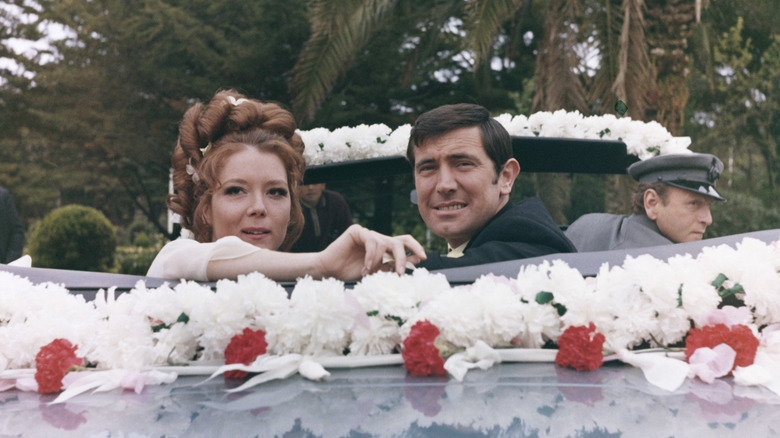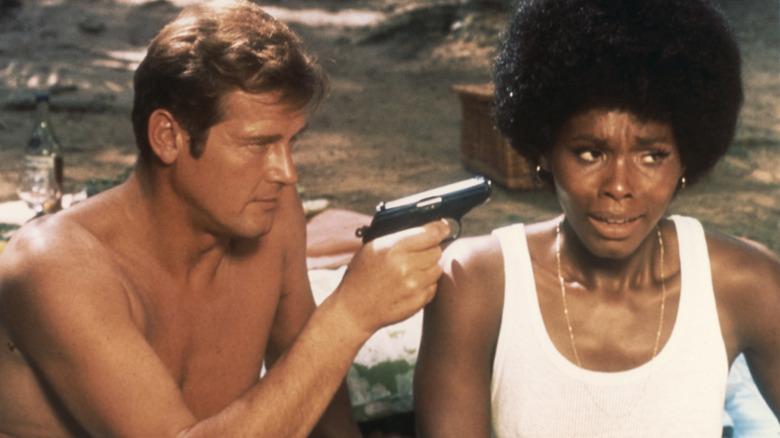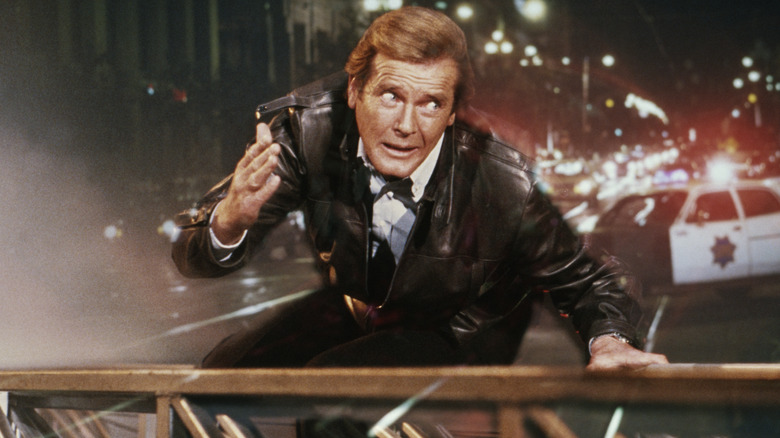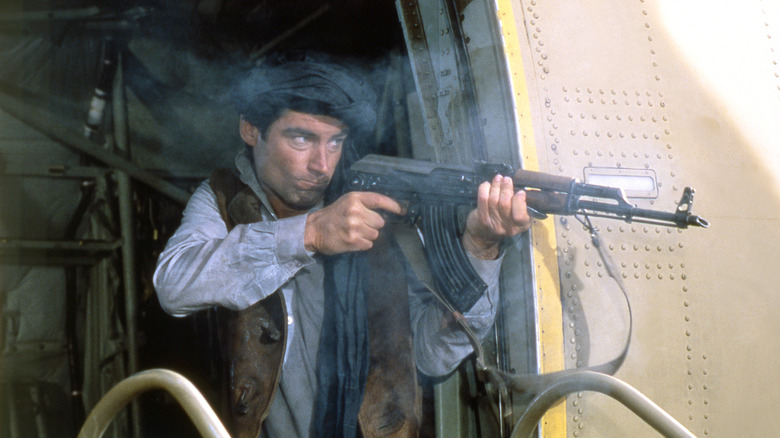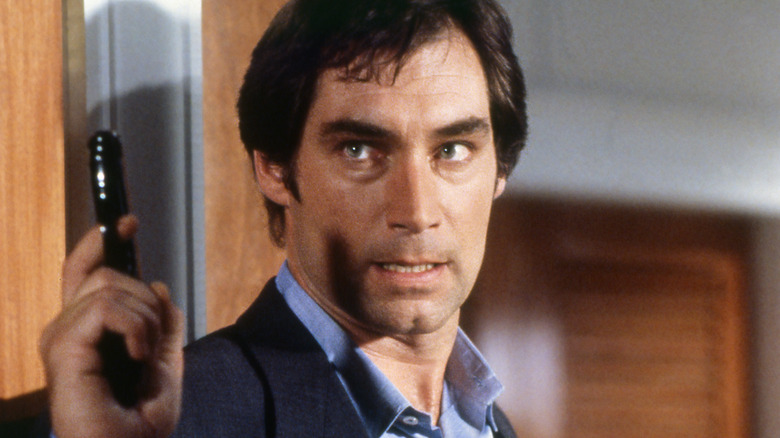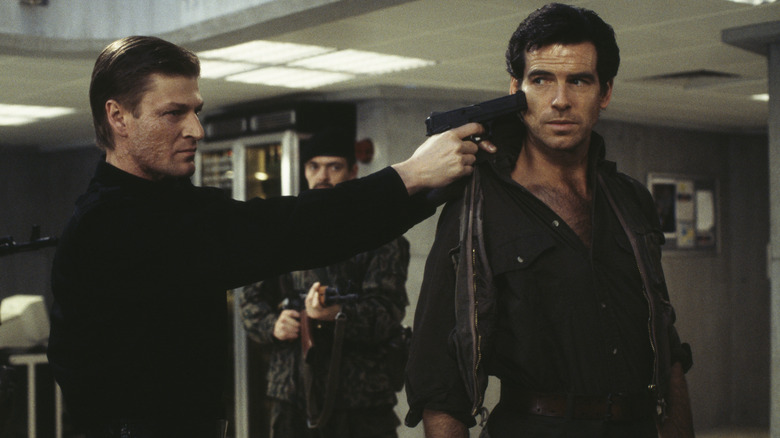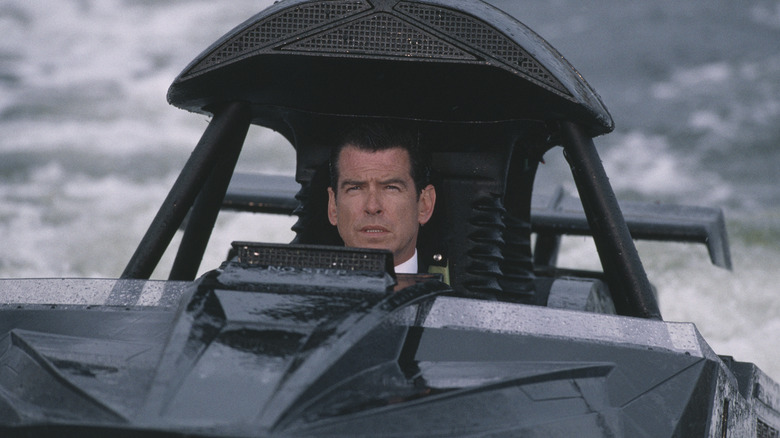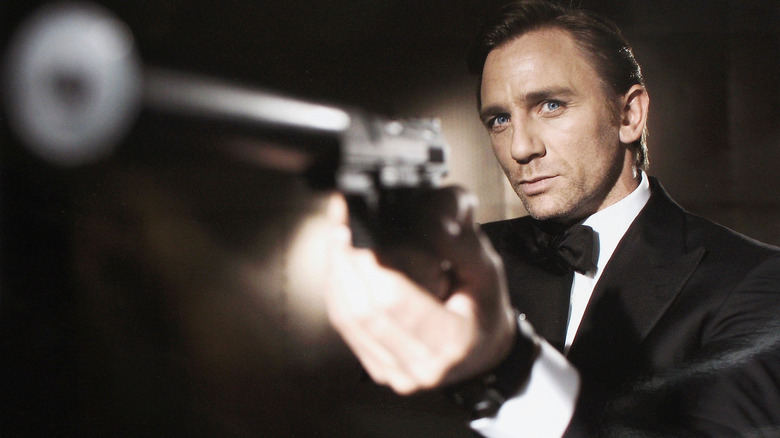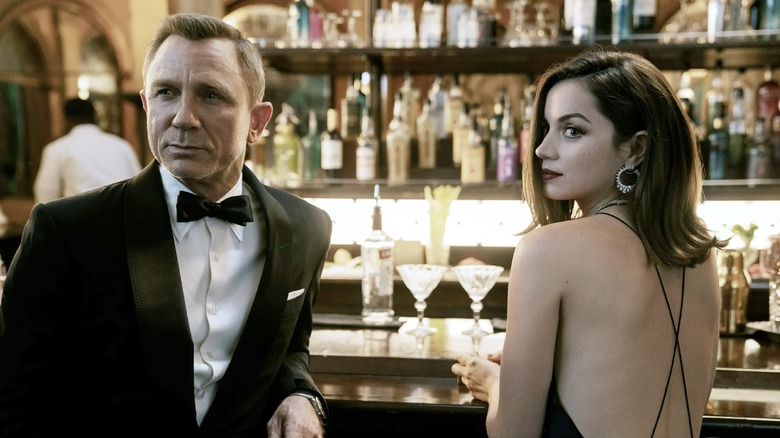James Bond: Every Actor In Order And How The Character Has Evolved Over Time
The James Bond film series isn't the only one that has ever had its lead character played by multiple people, but it is definitely one of the originators of that practice. That said, most other decades-long franchises deal with the passage of time by either having the same actor play a much older version of the character, or having a new, completely different character — typically some form of protégé of the original — take over as lead to facilitate a new actor. But the 007 franchise has dealt with its longevity by simply having a new actor play Bond every few years.
Up to this point, six different actors have portrayed James Bond across the 25 official movies produced by Eon Productions. Each one has brought their own unique take on the character to make it their own, while also honoring the way Bond was written in Ian Fleming's books. In terms of everyone who came after Sean Connery, they've also had to figure out how to not completely reinvent the character so as to maintain consistency, yet not come off as though they are simply trying to copy Connery. Some only got one or two chances to play the legendary secret agent, while others straddled multiple decades during their 007 run. But each one left their mark on the movies and the character himself, helping to guide the franchise into its next era and set things up for their inevitable replacement.
Sean Connery established the template
There is a certain segment of the James Bond fandom that will always be ride or die for Sean Connery's portrayal. Part of that is because he was the first actor to play 007 on screen, but it goes beyond that. Connery had the luxury of starring in adaptations of some of Ian Fleming's best Bond books. In both consensus-based ratings from the likes of Rotten Tomatoes, as well as our own personal rankings, "Dr. No," "Goldfinger," and "From Russia with Love" are almost always near the top of lists of the best Bond films — and "Thunderball" typically isn't far behind.
It wasn't just lucking into great scripts, though. Connery's work in bringing the character to life for the first time can't be denied, looking close enough to actor/musician Hoagy Carmichael — as the character is described by Vesper Lynd in the first Bond book, "Casino Royale" — to be accurate to how Fleming pictured him while also helping to develop the character as a more effective on-screen presence. In fact, it was Connery's idea for the character to introduce himself as "Bond, James Bond" in "Dr. No," a quote now as synonymous with the character as how he likes his martinis prepared. For that reason and many more, Connery did a lot to establish James Bond as the iconic movie character he quickly became.
Connery was also the first Bond actor to overstay his welcome
Unfortunately, a negative tradition also began with the first actor to play James Bond — portraying the character for a little too long. In Sean Connery's defense, he wanted to be done with the franchise after 1967's "You Only Live Twice" and was lured back after the unexpectedly sudden departure of his replacement, George Lazenby. Even so, Connery's advancing age was already starting to show in "You Only Live Twice," and few would disagree that he would have been better off bowing out after "Thunderball" and going out on top.
Speaking of "Thunderball," Connery would later make the strange decision to return as Bond on film one last time for 1983's "Never Say Never Again" — a second adaptation of the "Thunderball" book that was released as part of a complicated and prolonged legal battle over the film rights to said book. Though not made by Eon Productions, "Never Say Never Again" still had a sense of legitimacy that the ridiculous 1967 version of "Casino Royale" — the only other non-Eon Bond film — lacked, in that it had Connery as 007. But it did see Connery playing the character at 52 years old — though he was still three years younger than Roger Moore, the "official" Bond actor at the time.
George Lazenby brought youth back to Bond
When Sean Connery decided to quit playing Bond (the first time), the 007 movies were still extremely popular — so the studio wasn't about to abandon the franchise just because it lost its lead. So the search was on to find Connery's replacement, who ended up being a complete unknown named George Lazenby. Remarkably, playing James Bond was Lazenby's very first screen credit other than commercial work. Yet he beat out more established actors — including two future James Bonds — for the privilege of being the new 007.
Among the pros of having to find a new Bond was that the secret agent could be young again, with Lazenby being nine years Connery's junior. But it wasn't a total reboot, as M (Bernard Lee), Q (Desmond LLewelyn), and Miss Moneypenny (Lois Maxwell) were all still played by the same actors who had previously starred alongside Connery. It allowed for a direct continuation of the existing universe while also magically turning back the clock on Bond's age. While reactions to Lazenby's portrayal were mixed, and he remains the automatic go-to "worst Bond" in many people's minds, there's no denying that he was a tougher Bond, one who actually seemed to know how to throw a punch. That translated into the earliest example of a more physically brutal Bond that wouldn't be fully explored again until Daniel Craig.
Lazenby's Bond experienced both love and loss
Because George Lazenby is something of an undeserved punchline in the eyes of many when revisiting Bond's film history, his sole entry — "On Her Majesty's Secret Service" — was initially relegated to the low end of many 007 movie rankings. But to dismiss that film is to overlook a major evolution for the character on screen, humanizing him in a way that neither previous nor most subsequent movies ever really bothered to do.
While Bond technically got married to Kissy Suzuki (Mie Hama) in "You Only Live Twice," it was a sham wedding for subterfuge purposes. His marriage to Tracy di Vicenzo (Diana Riggs) in "OHMSS" was one of genuine love, and showed that James Bond truly was capable of giving his heart to a woman. Yet Tracy's shocking murder at the end of the film has Bond experiencing a personal tragedy the likes of which we wouldn't see again until 37 years and four Bonds later, when Daniel Craig's 007 falls for and subsequently loses Vesper Lynd (Eva Green) in "Casino Royale." While that aspect of Craig's Bond was seen as a huge step forward for the character and the series, Lazenby did it first, and not enough people give him credit for that.
Roger Moore began his Bond run by diving into blaxploitation
There's a lot of conflicting information about George Lazenby's exit from the Bond franchise after only one film — but, to hear him tell it, the studio was ready to sign him up for six more 007 films when he decided that one was enough. Either way, his departure left Eon in the lurch and there was a bit of a scramble to replace him — leading to Eon convincing Sean Connery to return one last time in "Diamonds Are Forever," until a more permanent replacement could be secured.
That replacement ended up being Roger Moore, who was actually older than Connery. Apparently, there was an assumption that going younger with Lazenby was the wrong move, given all that went down behind the scenes with him, so it was decided to make Bond a middle-aged man again. Moore got what remains one of the more unusual Bond debuts in history with "Live and Let Die," which was as much a blaxploitation movie as a film about a suave British secret agent. Though the movie itself was and remains a divisive 007 entry, Moore proved a great choice for Bond and was ready to usher the character into an era filled with other films that both experimented with different genres and really played up the more fun and campy side of the character.
Moore brought his overlong era to a tired, awkward finish
Roger Moore had the unenviable task of having to both follow up Sean Connery while also making up for what was perceived as George Lazenby's misstep. With that in mind, he was an excellent Bond overall, the top choice of many 007 fans if not seen as at least Connery's equal. People appreciated the levity he brought to the role, seemingly to genuinely have fun with it. His movies could get a little too ridiculous at times, but entries like "The Spy Who Loved Me" and "Moonraker" remain great examples of the series going over the top in a good way. That said, Moore was also capable of more stripped-down, somber outings, like the solid "For Your Eyes Only."
Unfortunately, Moore's prevailing 007 legacy is sometimes that of the man who played Bond for too long. To be fair, Daniel Craig was also in his 50s by the time he closed out his era, but he didn't look or act like it. Moore, on the other hand, very much exhibited the fact that he was pushing 60 and that his body had had enough in every bit of his performance in "A View to a Kill" — it's not at all hard to imagine him limping over to the nearest chair, hands on his lower back and wincing in pain, between each and every take. Thankfully, it would be the last time a Bond actor stayed past his prime.
Timothy Dalton was meant to be everything Moore wasn't
While there was a lot of fun to be had in Roger Moore's Bond era, the pop culture landscape was different by the time he turned in his tux after 1985's critically and commercially disappointing "A View to a Kill." Action movies had gotten darker, grittier, and more violent, and the lingering '70s-era camp of the previous generation of Bond films had started to make it feel like a series for dads rather than the much-coveted younger demos. So, for the first post-Moore movie, the series traded in the humor and the camp for a much edgier and more brutal vibe — and a much more serious Bond to match.
Interestingly, it was Pierce Brosnan who was initially eyed to replace Moore, but he was still attached to the TV show "Remington Steele" at the time and Bond producers didn't want their new lead to be James Bond and a current TV character at the same time. So the role went to Timothy Dalton instead, who had a very Brosnan-esque look and was also up to the task of taking 007 in the new direction that the next era was aiming for. But not everyone was sold on a largely humorless Bond, and Dalton's time in the role got off to a shaky start.
Dalton's grittier era was simply ahead of its time
Timothy Dalton would ultimately only star in two Bond movies, largely because he wanted to decide on future appearances on a film-by-film basis while the studio insisted he had to commit to multiple sequels all at once. When he wasn't willing to do that, he was let go. But he also didn't have much in the way of bargaining power given that neither of his movies were especially well-received. The world might have eventually gotten more comfortable with the new, more serious, and more violent vibe of Dalton's stint if it had been given more room to grow, but that didn't end up happening.
Of course, we now know just how well a darker, edgier Bond can work given the major critical and commercial success of Daniel Craig's run. And reappraisals of Dalton's two 007 movies have been much more positive than they were at the time. It would seem that it just wasn't the right moment for that take on the franchise, and 007 fans wanted at least one more era of a suave, smirking, gadget-loving Bond before they were finally ready to let the character grow up, as it were.
Pierce Brosnan debuts as 007 with one of the best entries
It was only fair that Pierce Brosnan finally get the chance to play Bond, given that he was previously screwed out of the role by NBC. The network renewed "Remington Steele" for no other reason than to capitalize on Brosnan's popularity boost while he was being considered for 007 — only to squeeze a measly five more episodes out of him. For his troubles, he was blessed with a dynamite film with which to make his 007 debut — 1995's "GoldenEye." As for his portrayal of the character, Brosnan struck the perfect balance between the fresher, more modern Bond that Dalton was going for while also drawing from the lighter charm and charisma of Moore and Connery.
It's worth noting the video game adaptation of the movie, titled "GoldenEye 007" and released in 1997 for the Nintendo 64. It earned raves upon release and was a massive seller, going on to be considered one of the best video games of all time. It brought Bond into the digital world in a more satisfying way than most of his action movie peers, of any era, and was so successful that James Bond video games essentially became a genre all their own — some even having entirely original stories, villains, and theme songs not taken from any of the films. The impact of "GoldenEye" on video games was actually even greater than it was on cinema.
Brosnan's Bond era was later marred by style over substance
As great as "GoldenEye" was, it was more or less all downhill from there for Pierce Brosnan's Bond era. Each of his subsequent three films were critically panned, though they generally still performed well at the box office. The action and the set pieces were there, but the plots and the villains were some of the weakest examples of both in the entire history of the franchise. It's not as though a 007 film had never been accused of style over substance before — in fact, those less in love with the franchise might say that label applies to the entire series, especially pre-Craig — but the criticism was especially valid in the Brosnan era.
It didn't help that computer-generated effects had increased in prominence as Brosnan's 007 films went on, except that such effects were still in their infancy and only a select few films from that era managed to use them effectively. Brosnan's final Bond outing, 2002's "Die Another Day," will be forever linked to its embarrassingly bad surfing scene that looked terrible even at the time — to say nothing of how badly it has aged. Even some of the oldest Bond movies have held up remarkably well in terms of effects and set pieces, so the fact that one released this millennium has perhaps the most laughable scene in the entire series from an effects standpoint is pretty bad.
Daniel Craig took the franchise back to the beginning
Perceived quality aside, "Die Another Day" was a massive hit at the box office — in fact, it was the highest-grossing Bond film of all time up to that point. But it's not always because the series has waned in popularity that 007's producers decide to transition into the next era and find a new lead. In fact, it would seem that it was partly because of Brosnan's box office success in the role that he ended up getting fired from it, with the actor apparently wanting more money to continue than the studio was willing to pay.
Once Brosnan was let go, it felt like the perfect opportunity to hit the reset button on the series in a more drastic way than had ever been done before. In fact, the next 007 movie went all the way back to the first James Bond book, "Casino Royale," as a way to send a pretty obvious message that the franchise was starting completely fresh. Daniel Craig's casting wasn't without backlash, particularly because of his blond hair, strangely enough. But the naysayers were silenced once the movie came out and everyone saw that not only was Craig the perfect Bond for the modern era — smooth but also athletic and brutal in a way that no Bond had ever been — but "Casino Royale" was one of the best 007 movies yet.
Will Craig's Bond run be an impossible act to follow?
Daniel Craig's run had its ups and downs, but there's no denying that his legacy as one of the best Bonds so far has been well-earned. Not to mention that "Skyfall" easily secured its place among the greatest Bond movies ever made, with some even proclaiming it the new #1. With Craig's time in the role finished after 2021's "No Time to Die," talk has turned to who the next Bond should be and what the future holds for the franchise.
It would feel redundant to carry on with the exact same vibe as Craig's Bond era, only with a different actor. But at the same time, his 007 films were everything that the franchise should have been for the current cinematic landscape. It's already been two years since "No Time to Die," and there has been absolutely nothing officially announced in the way of the next Bond or even when to expect another movie. This makes it pretty obvious that it's not clear how to proceed with the franchise or the character at this point.
So definitive was Craig and his era that talk quickly turned to the next Bond being a woman and/or a person of color, with rumblings of even having an entirely different character lead the next phase of the 007 franchise. The last run of films, and the man who led them, may prove to be a tough act to follow indeed.
